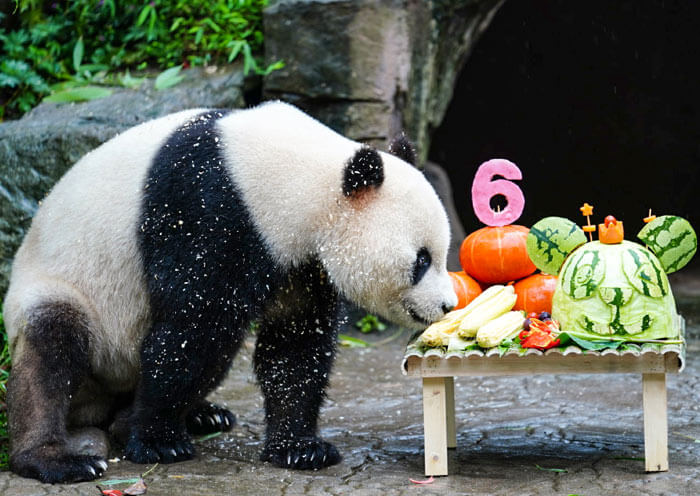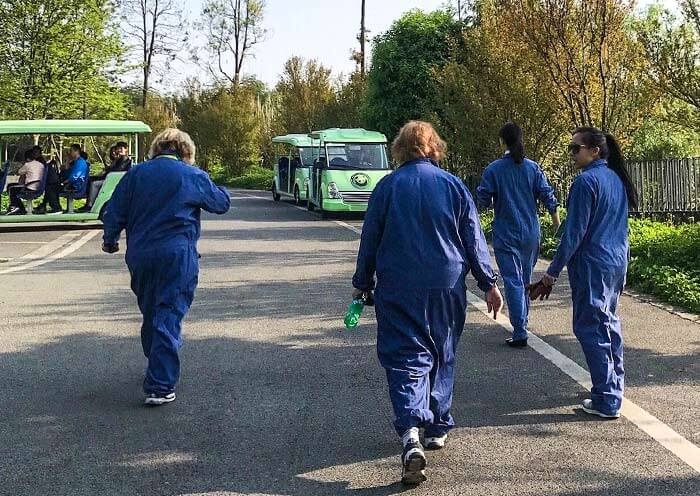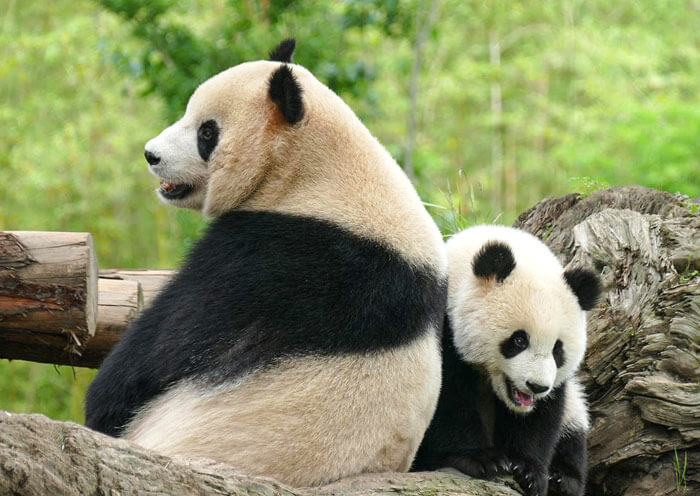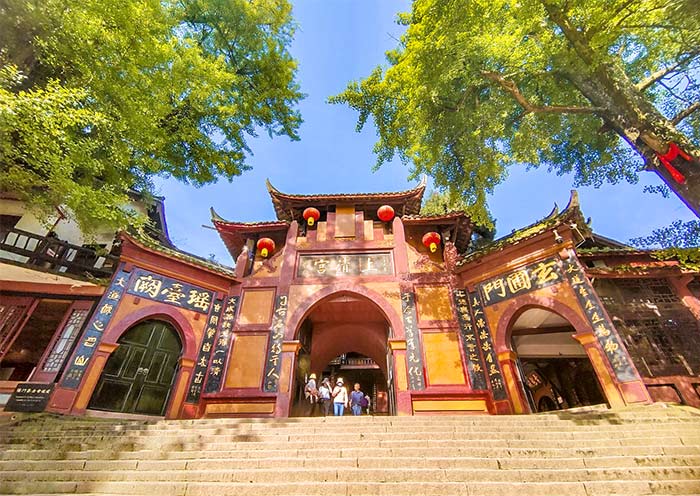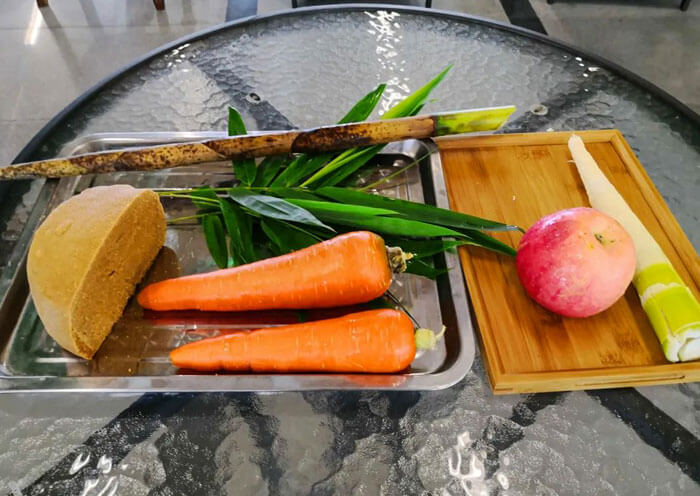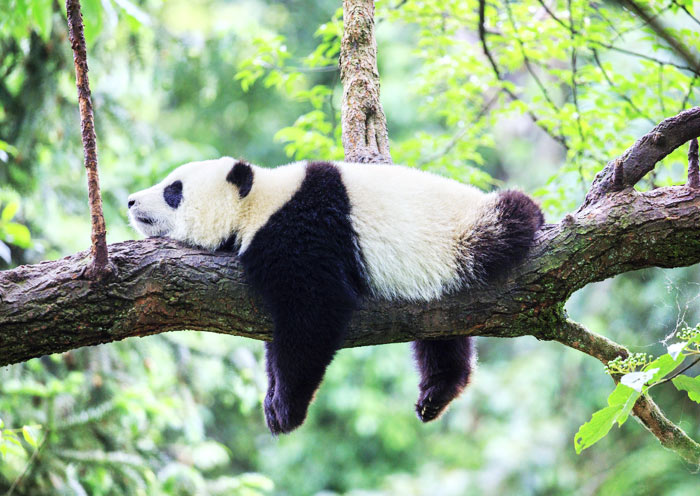In the morning, you will meet your guide at the appointed time in your hotel lobby. Since the Panda Volunteer Program starts at 8:30 am, we will depart early for Dujiangyan Panda Base, which is located about 67 kilometers (1.5 hours drive) away from Chengdu city center. All pandas that go abroad or return to China must stay at this base for a mandatory observation period of three months before they can enter or leave. This base also known as the “Panda Customs”.This is the closest Panda Volunteer Base to Chengdu where you can fulfill your panda keeper dream.
This base is the only research and conservation institution combines panda diseases prevention, wildlife rescue, education, and international exchanges. Located near the giant panda habitat world heritage area, it has a suitable environment for pandas and boasts negative oxygen ions up to 91%, an ideal setting to enjoy the pandas and experience a full-body spa. In this Dujiangyan Panda Volunteer Tour, you can observe pandas in a semi-natural habitat, learn about their behavior, and gain insights into ongoing conservation efforts, such as raising the number of pandas through captive-breeding programs and returning captive pandas back to the wild. In addition to the 46 giant pandas, there are also panda companion animals living in the panda ark, such as fourteen pheasants (including golden pheasants), two Asian black bears (brothers rescued from the wild), nineteen red pandas, and more. It is very interesting that the two black bears are named Xiong Da (熊大) and Xiong Er (熊二) after the famous Chinese cartoon Boonie Bears (熊出没).
What does a Panda Volunteer do? Upon arrival at the Dujiangyan Panda Ark, you need to sign a safety agreement and receive a volunteer work card, clothes, and gloves. You will have the chance to watch panda keepers pick up panda feces, add fresh bamboo, and clean the panda enclosures. You will visit various panda enclosures, observe the behavior of the giant pandas, and learn about the stories behind different pandas. You will also have the opportunity to learn about panda cake recipes and make panda cake. After watching the panda nanny feeding and training the pandas, it will be time to feed yourself at the panda nanny's canteen. Then, you can take a short rest and watch panda documentaries. Finally, you will receive your Panda Volunteer Certificate, take a group photo, and return your work card.
To become a processional panda fan, here is a list of Panda Stars that live in Dujiangyan Panda Ark for your reference:
1.Bai Yun, a female panda born in 1991, is a heroic mother of six, a grandmother of eight, and a great-grandmother of two. As the first panda on loan, Bai Yun is an oversea returnee panda who used to live in the San Diego Zoo for 23 years (1996-2019). She is now over 32 years old, which is equivalent to a human being who is over 100 years old. The average lifespan of a giant panda is around 25 years, while in the wild, they generally live to be around 20 years old. Under captive conditions, the longest recorded lifespan for a giant panda is around 38 years old. Bai Yun enjoy her retired life here, happily surrounded by her long mate Gao Gao, her first Child Hua Mei, her nannies, and her fans.
2.Gao Gao, a male panda born in 1991, was rescued in 1993 from the wild. He is an oversea returnee panda who used to live in the San Diego Zoo for 15 years (2003-2018). Gao Gao and Bai Yun are a loving couple, and together they produced five offspring, namely Mei Sheng, Su Lin, Zhen Zhen, Yun Zi, and Xiao Li Wu. Gao Gao is handsome with a gentle personality. He is also a television star, having played the leading role in the documentary "Homecoming", which vividly captures the touching story between humans and pandas.
3.Hua Mei, a female panda born in San Diego Zoo of America in 1999, is the first child of Bai Yun and was the first giant panda born in the US to survive to adulthood. On its 100th day of birth, it was named Hua Mei by Li Zhaoxing, the Chinese ambassador to the United States, symbolizing the strong friendship between China and the United States (“Hua” means “China” in Chinese, “Mei” means ” the USA”). Hua Mei is a superstar who has received many letters and greeting cards from her fans. Hua Mei is also the world's first giant panda born overseas and returned to its hometown. Hua Mei went back to China in 2004, and she is a super mother like her mother. As of 2019, Hua Mei has given birth to five sets of twins, making her a true “heroic mother” in the giant panda world.
4.Dai Li, a male panda born in 1999, was rescued in 2001 from the wild in BaoXing of Sichuan. Severely injured in his left hind limb, Dai Li becomes the world's first giant panda with amputated limbs. Three legs cannot hinder his love for life, Dai Li is happy, strong, and good at fighting. He also likes to lie on the wall and observe its neighbors and is known as the "Number One Gossip Bear of the Base".
5.Cao Cao, a female panda born in 2002, was rescued from the wild in late 2003. Abandoned by her careless mother, Caocao was rescued by kind-hearted villagers. Perhaps due to her experience of being rescued, she had no guard against humans and was extremely gentle. With her innate maternal instincts and scientific training by researchers, Caocao became the first giant panda to be successfully reintroduced into the wild through captive breeding in the 40 years of giant panda conservation efforts and also the first giant panda reintroduced into the wild worldwide. Caocao is an outstanding mother, having given birth to many cubs, including Tao Tao and Hua Jiao, who were reintroduced into the wild separately in 2012 and 2015, as well as Hua Hu and Wu Yang, who currently reside in the panda base. In 2018, Caocao successfully mated with a wild giant panda and gave birth to twins named He He and Mei Mei, the first captive-bred giant panda twins to survive in the wild, which was certified by Guinness World Records. Caocao, who went from the wild to captivity and back to the wild, has shown us more possibilities for captive-bred giant pandas to be released into the wild, and has also inspired the staff working on giant panda reintroduction to continuously improve their efforts.
6.Qing Qing is a male panda born in 2015 at Ya’an Bifengxia Panda Base. Qing Qing (meaning “Indigo” in Chinese) has a twin sister named Bing Bing (meaning “Ice”). The names "Qing Qing" and "Bing Bing" not only refer to the saying “Indigo is derived from blue but is more pleasing than blue; ice is formed out of the water but is colder than water”, but also allude to the legend of Li Bing (the same "Bing" as Bing Bing) building the Dujiangyan Irrigation System and guarding Qingcheng Mountain (the same "Qing" as Qing Qing). Qing Qing is a popular internet celebrity, known for his love of rolling in water ditches since he was a cub, earning him the nickname "Man Yue Mei"(蔓越莓Coal Ball) by netizens. While milk (盆盆奶) is usually a favorite among baby pandas, Qing Qing is an exception, and his panda keeper Yang had to come up with creative ways to get him to drink it. Why is Qing Qing so famous? In March 2016, a video of Qing Qing being forced to take a bath by his mother went viral on the internet and was even published by the UK's Daily Mail. In August 2016, Qing Qing went viral again for a video of his failed attempt to escape. On March 16, 2023, a video of Qing Qing standing with his hands on his hips and staring at his panda keeper went viral, earning him the title of "Little Boss of Mount Qingcheng". On April 14, 2023, a video of Qing Qing choking on a carrot while eating went viral on the internet. Fortunately, his caretaker noticed and performed a 'panda version' of the Heimlich maneuver, saving his life. Today, Qing Qing is a father, but he is still the active and playful cub in everyone's hearts.
Take your time to discover more about the panda stars and panda stories.
Kindly take note of the following:
1. Booking Note: The Panda Volunteer Program has a daily limit of 80 participants. Contact us in advance to secure your spot.
2. Age Limit: Volunteers must be between 10 and 70 years old. We also offer other activities, such as watching documentary movies and making panda cakes.
3. Physical Examination Report is required for the Panda Volunteer Program Application. Please check the PDF for the form and contact us for any questions.
4. Dress Code: To prevent slipping, avoid wearing short pants or slippery footwear. Do not wear perfume or nail polish as pandas have a strong sense of smell. Thank you for respecting the pandas.
5. Chinese Lunch: The panda keeper‘s canteen mainly offer two meat dishes, one vegetable dish, rice, and porridge. Prepare some snacks if you do not like the food there.
In the afternoon, it's time to visit the Mount Qingcheng (World Heritage Site), one of the cradles of Taoism in China. The founder of Taoism, Zhao Daoling (25–220), believed that the tranquil and serene natural scenery of Mount Qingcheng was suitable for the development and prosperity of Taoism. Therefore, it is considered the birthplace of Taoism. The Qingcheng mountain range has 36 peaks, which stand in a circle like an ancient wall protecting a city. With green trees growing on the mountains all year round, it is called Mount Qingcheng - "Green City Wall Mountains"("Qing" means "green" in Chinese and "Cheng" means "city"). Mt. Qingcheng is like a "Wall of Hills" protecting Panda Valley.
As you may know, Mount Qingcheng is the inspiration for the Kung Fu Panda Movies. In Kung Fu Panda 2, the gate of Mount Qingcheng was depicted in the Valley of Peace. In Kung Fu Panda 3, when Po reunites with his biological father Li Shan and his fellow pandas, we see Panda Village, which is hidden in the Qingcheng Mountains like a utopia. Why Kung Fu Panda filmmakers choose Mount Qingcheng as the Panda Village? To create a visually stunning setting that was culturally significant with Taoism and Chinese culture, the found that Mount Qingcheng provided the perfect backdrop for the story. They also incorporated elements of traditional Chinese architecture and design into the village, such as the ornate roofs and red lanterns, to further emphasize the cultural significance of the location. In addition to its cultural significance, Mount Qingcheng is also home to several endangered species, including the giant panda.
As the closest and greatest mountain for hiking near Chengdu, Mount Qingcheng offers a variety of hiking trails, ranging from easy walks to challenging climbs. Welcome to hiking in the Kung Fu Panda Po’s Panda Village. During the hike, you can explore the Taoist temples, waterfalls, streams, and forests. To reach the summit, you can take a sightseeing car to the entrance, then walk for 20 minutes to the cable car station near Yuecheng Lake (optional ferry available) to go up (a 5-minute cable car ride). From there, it takes about 1 hour to hike to the summit or about 3-4 hours to hike the entire way on foot. During the hike, you can explore Tianshi Celestial Cave (famous for the 1000-year-old ginkgo tree planted by the founder of Taoism), Shangqing Palace (the biggest Taoist temple in Qingcheng), and Lao Jun Ge Pagoda (best spot to view the summit of Mt. Qingcheng). The hike down takes about 2 hours (optional cable car ride available). If time permit, don’t miss the Jianfu Palace, located near the entrance, which was originally constructed in the Tang Dynasty (618-907). Local people like to have a cup of tea there on weekends. Although the palace looks ordinary from the outside, red lanterns hang all over the palace, making it a surprise when entering, especially under the contrast of the green trees in and around the palace.
Then, it is time to end your 1-day Chengdu Tour with Dujiangyan Panda Volunteer Program. Your guide will escort you to your hotel or the airport/train station for your flight or high speed train to your next destination.
Thank you for choosing Asia Odyssey Travel for your Chengdu tour, and we are always here working for you and hope to see you again for your next trip around China/Asia.



